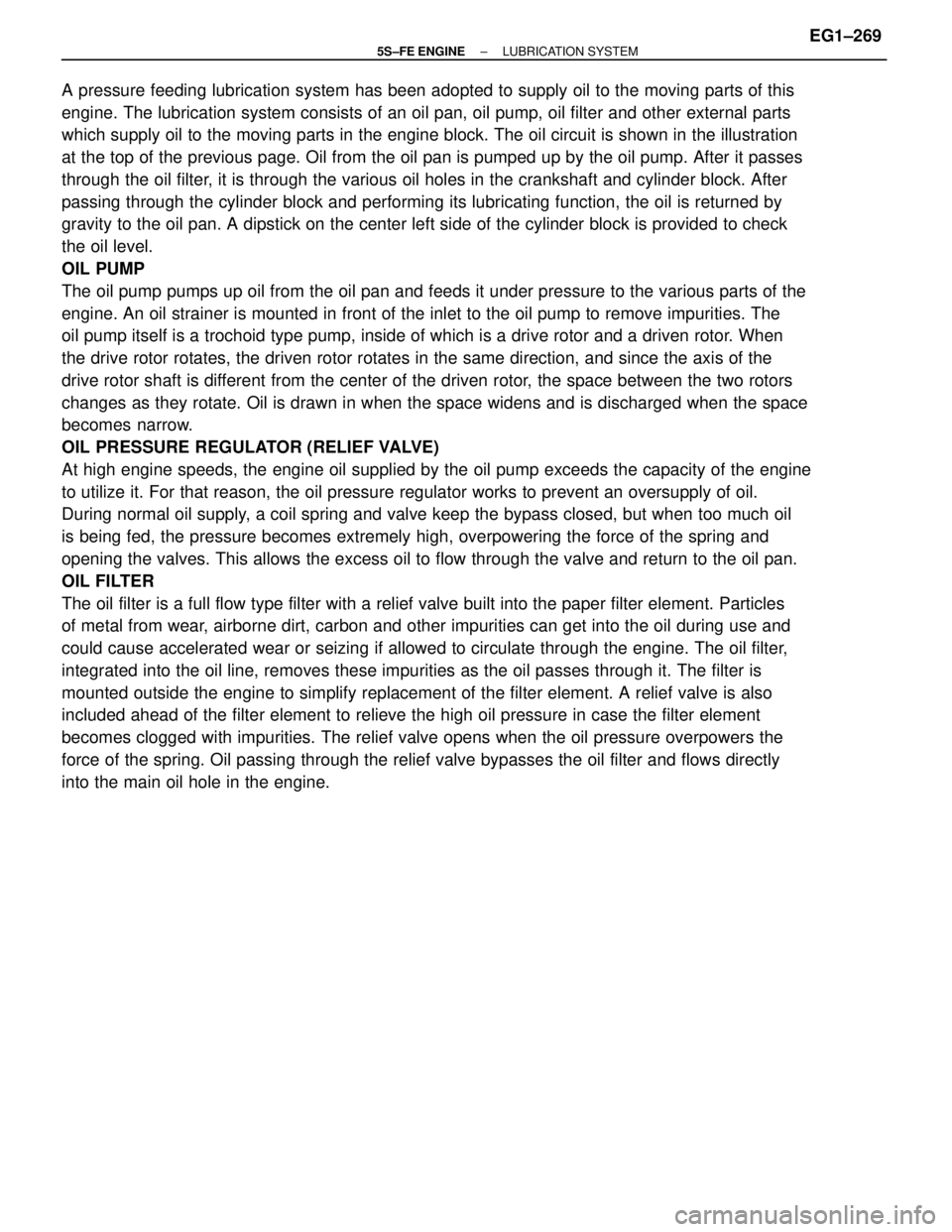Page 21 of 4770

3
CAMRY ± NEW FEATURES
167CN05
WU-TWC
167CN06
TWCSub MufflerMain Muffler41
5. Intake and Exhaust System
Throttle Body
The throttle body is basically the same as that of the 5S-FE engine. However, to ensure the starting perfor-
mance at low temperatures, the air passage for the IAC (Idle Air Control) has been increased on the 5S-FNE
engine. The IAC valve is a 1-coil type with a built-in driver.
Exhaust Manifold
As in the California specification 5S-FE engine,
the stainless steel exhaust manifold and WU-
TWC (Warm Up Three-Way Catalytic Convert-
er) have been integrated to improve the warm-up
performance of TWC, thus reducing exhaust
emissions.
However, the 5S-FNE engine uses a catalytic
converter that has been designed exclusively for
the CNG application, in which the loading of the
noble metal has been increased.
Exhaust Pipe
1) General
�To secure sufficient luggage compartment capacity, the main muffler has been relocated below the rear
seat. Furthermore, the muffler capacity has been increased.
�A 2-way exhaust control system has been adopted to improve engine performance and reduce the exhaust
noise.
�Similar to the WU-TWC, the TWC (Three-Way Catalytic Converter) has been designed exclusively for
the CNG application, in which the loading of the noble metal has been increased.
Page 132 of 4770
37. A/T:
CONNECT AND ADJUST THROTTLE CABLE
38. CONNECT AND ADJUST ACCELERATOR CABLE
39. FILL WITH ENGINE COOLANT
Capacity:
6.3 liters (6.7 US qts, 5.5 Imp. qts)
40. CONNECT NEGATIVE (±) TERMINAL CABLE TO
BATTERY
41. START ENGINE AND CHECK FOR LEAKS
42. ADJUST IGNITION TIMING
(See page IG ±19 and 38)
Ignition timing:
10� BTDC @ idle
(w/ Terminals TO and E1 connected)
43. PERFORM ROAD TEST
Check for abnormal noise, shock, slippage, correct shift
points and smooth operation.
44. RECHECK ENGINE COOLANT LEVEL AND OIL
LEVEL
± 5S±FE ENGINEENGINE MECHANICALEG1±82
Page 290 of 4770
PREPARATION
SST (SPECIAL SERVICE TOOLS)
RECOMMENDED TOOLS
09082±00050 TOYOTA Electrical Tester Set09230±01010 Radiator Service Tool Set
6.3 liters (6.7 US qts, 5.5 Imp. qts)Engine coolant temperature switch
Engine coolant temperature switch 09228±06500 Oil Filter Wrench
Engine coolant (w/ Heater)
EQUIPMENT
Radiator cap tester
Ethylene±glycol base
COOLANT
Torque wrenchThermometer
Classification Capacity Heater
Item
± 5S±FE ENGINECOOLING SYSTEMEG1±240
Page 291 of 4770

2. CHECK ENGINE COOLANT QUALITY
There should not be any excessive deposits of rust or
scales around the radiator cap or radiator filler hole,
and the engine coolant should be free from oil.
If excessively dirty, replace the engine coolant.
3. REPLACE ENGINE COOLANT
(a) Remove the radiator cap.
CAUTION: To avoid the danger of being burned, do not
remove It while the engine and radiator are still hot, as
fluid and steam can be blown out under pressure.
(b) Drain the engine coolant from the radiator drain cock
and engine drain plug. (Engine drain plug at the right
rear of cylinder block.)
(c) Close the drain cock and plug.
Torque (Engine drain plug):
13 N±m (130 kgf±cm, 9 ft±lbf)
(d) Slowly fill the system with coolant.
Use a good brand of ethylene±glycol base
coolant and mix it according to the
manufacturer 's directions.
Using engine coolant which includes more than
5096 ethylene±glycol (but not more than 7096) is
recommended.
NOTICE:
wDo not use a alcohol type coolant.
wThe engine coolant should be mixed with demineral±
ized water or distilled water.
Capacity (w/ Heater):
8.3 liters (6.7 US qts, 5.5 Imp.qts)
(a) Reinstall the radiator cap.
(f) Warm up the engine and check for leaks.
(g) Recheck the engine coolant level and refill as neces±
sary.
COOLANT CHECK AND
REPLACEMENT
1. CHECK ENGINE COOLANT LEVEL AT RESERVOIR
TANK
The engine coolant level should be between the
ºLOWº and ªFULLº lines.
If low, check for leaks and add engine coolant up to
the ªFULLº line.
± 5S±FE ENGINECOOLING SYSTEMEG1±241
Page 319 of 4770

A pressure feeding lubrication system has been adopted to supply oil to the moving parts of this
engine. The lubrication system consists of an oil pan, oil pump, oil filter and other external parts
which supply oil to the moving parts in the engine block. The oil circuit is shown in the illustration
at the top of the previous page. Oil from the oil pan is pumped up by the oil pump. After it passes
through the oil filter, it is through the various oil holes in the crankshaft and cylinder block. After
passing through the cylinder block and performing its lubricating function, the oil is returned by
gravity to the oil pan. A dipstick on the center left side of the cylinder block is provided to check
the oil level.
OIL PUMP
The oil pump pumps up oil from the oil pan and feeds it under pressure to the various parts of the
engine. An oil strainer is mounted in front of the inlet to the oil pump to remove impurities. The
oil pump itself is a trochoid type pump, inside of which is a drive rotor and a driven rotor. When
the drive rotor rotates, the driven rotor rotates in the same direction, and since the axis of the
drive rotor shaft is different from the center of the driven rotor, the space between the two rotors
changes as they rotate. Oil is drawn in when the space widens and is discharged when the space
becomes narrow.
OIL PRESSURE REGULATOR (RELIEF VALVE)
At high engine speeds, the engine oil supplied by the oil pump exceeds the capacity of the engine
to utilize it. For that reason, the oil pressure regulator works to prevent an oversupply of oil.
During normal oil supply, a coil spring and valve keep the bypass closed, but when too much oil
is being fed, the pressure becomes extremely high, overpowering the force of the spring and
opening the valves. This allows the excess oil to flow through the valve and return to the oil pan.
OIL FILTER
The oil filter is a full flow type filter with a relief valve built into the paper filter element. Particles
of metal from wear, airborne dirt, carbon and other impurities can get into the oil during use and
could cause accelerated wear or seizing if allowed to circulate through the engine. The oil filter,
integrated into the oil line, removes these impurities as the oil passes through it. The filter is
mounted outside the engine to simplify replacement of the filter element. A relief valve is also
included ahead of the filter element to relieve the high oil pressure in case the filter element
becomes clogged with impurities. The relief valve opens when the oil pressure overpowers the
force of the spring. Oil passing through the relief valve bypasses the oil filter and flows directly
into the main oil hole in the engine.
± 5S±FE ENGINELUBRICATION SYSTEMEG1±269
Page 321 of 4770
Engine oil (M/T)
Dry fill
Drain and refill
w/ Oil filter change
w/o Oil filter change
Engine oil (A/T)
Dry fill
Drain and refill
w/ Oil filter change
w/o Oil filter changeAPI grade SG or SH, Energy±Conserving II
mutigrade engine oil or ILSAC multigrade
engine oil and recommended viscosity oil
08833±00080 Adhesive 1344,
THREE BOND 1344,
LOCTITE 242 or equivalent
SSM (SPECIAL SERVICE MATERIALS)
3.6 liters (3.8 US qts, 3.2 Imp. qts)
3.4 liters (3.6 US qts, 3.0 Imp. qts)
08826±00080 Seal packing or equivalent4.2 liters (4.4 US qts, 3.7 Imp. qts)
4.3 liters (4.5 US qts, 3.8 imp. qts)
LUBRICANT
Oil pressure switch Oil panClassification
Capacity
Item
3.6 liters (3.8 US qts, 3.2 Imp. qts)
3.4 liters (3.6 US qts, 3.0 Imp. qts)
± 5S±FE ENGINELUBRICATION SYSTEMEG1±271
Page 325 of 4770
3. FILL WITH ENGINE OIL
(a) Clean and install the oil drain plug with a new gasket.
Torque: 39 N±m (400 kgf±cm, 29 ft±lbf)
(b) Fill with new engine oil.
Oil grade: (See step 1 on page EG1±272)
Capacity (M/T):
Drain and refill
w/ Oil filter change
3.6 liters (3.8 US qts, 3.2 Imp. qts)
w/o Oil filter change
3.4 liters (3.6 US qts, 3.0 Imp. qts)
Dry fill
4.2 liters (4.4 US qts, 3.7 Imp. qts)
Capacity (A/T):
Drain and refill
w/ Oil filter change
3.6 liters (3.8 US qts, 3.2 Imp. qts)
w/o Oil filter change
3.4 liters (3.6 US qts, 3.0 Imp. qts)
Dry fill
4.3 liters (4.5 US qts, 3.8 Imp. qts)
(c) Reinstall the oil filler cap.
4. START ENGINE AND CHECK FOR LEAKS
5. RECHECK ENGINE OIL LEVEL
(See page EG1±272) (d) Lightly screw the oil filter into place, and tighten it
until the gasket contacts the seat.
(e) Using SST, tighten it an additional 3/4 turn.
SST 09228±06500 (c) Apply clean engine oil to the gasket of a new oil filter.
± 5S±FE ENGINELUBRICATION SYSTEMEG1±275
Page 535 of 4770
56CHASSISÐMANUAL TRANSAXLE
MANUAL TRANSAXLE
� DESCRIPTION
�The 5S±FE engine model uses the same S51 manual transaxle as in the previous model.
�The 1MZ±FE engine model ahs newly adopted the E153 manual transaxle. The basic construction and operation
of the E153 manual transaxle are the same as those of the '95 MR2. However, the differential gear ratio has been
changed to accommodate the characteristics of the engine.
�Specifications�
Model
NewPrevious'95 MR2
Transaxle TypeS51E153S51E153
Engine Type5S FE1MZ FE5S FE3S GTEItem5S±FE1MZ±FE5S±FE3S±GTE
1st3.5383.2303.5383.230
Gear2nd1.9601.9131.9601.913Gear
Ratio3rd1.2501.2581.2501.258
4th0.9450.9180.9450.918
5th0.731uuu
Reverse3.1533.5453.15347
Differential Gear Ratio3.9443.9333.9444.285
Oil Capacity
liters (US qts, Imp. qts)2.6 (2.7, 2.3)4.2 (4.4, 3.7)2.6 (2.7, 2.3)4.2 (4.4, 3.7)
Oil ViscositySAE75W±90uuu
Oil Grade API, GL±4 OR GL±5uAPI GL±3, GL±4 OR GL±5u